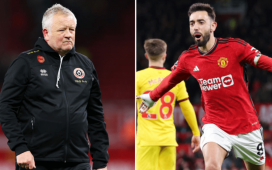NCAA Football 14 entered the world on July 9, 2013.
It turned out to be the last release of EA Sports’ college football franchise. Later that summer, in Ed O’Bannon’s case against the NCAA, a federal judge ruled it was an antitrust violation to have a video game that featured players’ likenesses without paying those players for their use. The NCAA wasn’t about to allow that, fearing player payment by a third party might some day lead a court to force colleges to pay players themselves.
Without schools willing to appear in the game and with the NCAA not letting college athletes take money for appearing, EA had no game to make.
Fans have spent the years since then clamoring for the return of a game that can’t possibly return until a handful of key things happen. Here’s where those dominoes stand.
1. The NCAA has to change the rules about player pay.
Progress grade: C
In October 2019, the NCAA said it would permit players to “benefit” from these kind of deals in a way “consistent with the collegiate model.” It wasn’t clear what that meant.
The organization has signaled a little more openness than before to letting college athletes take money for the use of their name, image, or likeness. That is probably because California enacted a law which will require that of schools in the Golden State, while Congress and several other states have bills in the works along the same line.
If the NCAA lifted the ban on players getting paid by third parties, it would theoretically allow players to collect money for appearing in a video game. That would seem to solve the legal problem at the core of the game’s disappearance after NCAA 14.
What’s not required here is for schools themselves to pay players, something they’re still loath to do. Payment would come from EA.
2. Once the NCAA lets them be paid, players need a way to collect money.
Progress grade: C
It’s easy to take for granted that Madden will ship every year with accurate, regularly updated rosters for every NFL team. That’s possible because EA has a relationship with the NFLPA, and the union has collective bargaining power for every active player. An EA-NFLPA relationship makes it simple for players to get a share of the money.
College athletes don’t have a body like the NFLPA. No organization has collective bargaining rights for football players. Even locally, there are no team unions to make the process easier. Northwestern busted football players’ union drive in the 2010s.
EA, according to both common sense and people in a position to know for sure, is never going to chase down more than 10,000 active FBS players per year to get their consent to appear in the game and be paid for it. It’s also not going to ship a game with the likenesses of unpaid players, because that would break the law.
There’s a solution, though. In October 2019, the NFLPA announced it was pairing with the National College Players Association to explore ways to “advance and market the group licensing rights of college athletes of all sports.” The NCPA, founded in 2001 by UCLA football players, is an advocacy organization for college athletes’ rights.
The NCPA doesn’t have the same power as a union like the NFLPA, in which every NFL player is automatically a member. But the organizations might be able to build a group licensing vehicle players could opt into, in order to make money from sources such as NCAA Football. Many would, and EA could exclude likenesses of players who didn’t sign up.
Another option is to make individual deals with certain players not in that licensing body. In those cases, don’t expect EA to pay a better rate than players in the group get, because the game-maker has an incentive to encourage everyone to be part of the group.
3. The NCAA’s schools, individually, also have to agree to appear.
Progress grade: C
Schools did this for years before O’Bannon’s case and a shifting national conversation about athlete rights drove them away.
Typically, schools license out logos, uniforms, and stadiums via a couple of massive licensing agencies that rep lots of schools. A few make their own deals.
Even schools that are part of the big licensing groups pulled out during the O’Bannon suit. A few conferences backed out en masse. The dynamic is such that all 14 SEC schools could appear in a future game, but the SEC itself might not — which would require EA to make up a name for the real yet fictional SEC.
A big handful of schools have grown more comfortable with appearing. Ten of them agreed to be in a partial college mode in Madden 20, which didn’t include any player likenesses. So did the College Football Playoff, which the NCAA doesn’t control. But you’ll notice there are no Big Ten schools in that Madden. That’s not a coincidence.
So, there’s still work ahead. When NCAA last came out, it had every FBS team. Getting all 130 schools onboard would be a lot of work. Bowl games, fight songs, apparel companies (notice those Nike cleats in Madden), and TV networks (like how ESPN often appeared in NCAA games) would require their own agreements. So would any neutral-site stadiums.
Another area EA could explore in a new NCAA is the licensing of real coaches. The studio long ago talked with the American Football Coaches Association about using members’ likenesses, but a deal never came together. If EA were using real players, there might be more of an appetite on both sides to also include real coaches.
It’s theoretically possible to construct a game with fake teams and let users upload logos, jerseys, and stadiums for real ones, but that’s not how EA does business. It’ll only make a game that meets its usual accuracy standards fresh out of the box.
4. EA Sports has to build a new game.
Progress grade: N/A
Even once every piece of paperwork is signed and the studio is forging ahead, EA will have tons of work to do in building a game that meets fans’ demands.
Expanding to include FCS teams is conceivable at some point (previous generations of the game included some), and that would only expand the number of deals needed. But EA is likely to start with FBS, because all of these things will be necessary:
- It’ll need to update its scans of stadiums, many of which have changed since 2013. It’ll also need refreshed uniforms for most schools.
- It’ll need to scan players’ faces. For Madden, EA gets a lot of rookies at offseason events like the Combine and NFLPA Rookie Premiere. College football doesn’t have many events like that, though EA could do scans at big high school combines and all-star games. Perhaps EA would distribute a tool by which players could scan themselves (or schools could help them do it in bulk).
- It’ll need to build rosters. That’s heavy work even in a game with 32 teams that have 53-man rosters. Accurately putting together 130-ish FBS rosters of 85 or 100 players will be a slog. (It’s already a slog for people who build these rosters for fun and share them on NCAA 14. Imagine how much of a slog it is when you’re trying to make something worth money.)
- It’ll have to revamp Dynasty mode considerably.
- Crucially, it’ll have to build a whole new version of NCAA Football gameplay that works on Frostbite, its current game engine. The studio’s pro and college games long played off each other, so that’s one partial advantage. EA could take a lot of things from recent Maddens and put them into a new college game. For instance, it’d now be easy to have RPOs in NCAA. But the two games are meant to have a noticeably different feel. NCAA is traditionally more arcade-like, lending itself to explosive offense. The controls are meant to feel a little different than in Madden. EA would probably like to keep those distinctions in place, according to people who’d know.
- And that new game will have to fit the next generation of gaming consoles (i.e. PlayStation 5 and whatever the next Xbox is), presenting its own development challenges. NCAA has not come out since gamers were playing it on the PlayStation 3.
One industry estimate is that EA would need one year to put out a passable but bare-bones version of NCAA. Coming back with a game on par with NCAA 14 would take two or three.
5. You need to figure out your first Dynasty mode team ahead of time, so you can hit the ground running.
Progress grade: depends on the person
This will involve gaming out who’s going to be the ideal team approximately two years from the time it becomes clear the game is coming back.
The key criteria for the perfect dynasty team are the same as ever:
- A cool stadium. It doesn’t need to be a big stadium or even a particularly nice stadium. It just has to look collegiate and visually pleasing. If a mountain range or a bunch of trees are visible while you’re playing a game, that’s a bonus.
- Nice uniforms. The good news here is that “nice” is in the eye of the beholder. I’d stay away from, like, Notre Dame, but that’s also because I want …
- Room to rise. It’s fine to eventually start up a dynasty at an already-good program. But that’s not what real ones do right when the game ships. Hardened gamers start with either a bad Power 5 team, a decent Group of 5 team that can rise and then be realigned into a power league, or — for the long-term builders among us — someone truly awful. If you do great in that job, then sure, you can take the LSU job after you’ve won a few titles.
Personally, I hope to win the 2025 Pac-12 with the Colorado State Rams.

Ron Chenoy-USA TODAY Sports
Some day, this checklist is likely to be completed.
The NCAA’s longtime notion of amateurism has cracked, both in court and in legislative houses. The people in charge of college sports still love nothing more than money, and there are still millions of people eager to pay $60 for a college football video game. The chances they come to their senses and let the rest of this list commence are strong.












